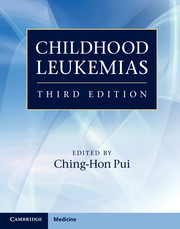Book contents
- Frontmatter
- Contents
- List of contributors
- Preface
- Section 1 History and general issues
- Section 2 Cell biology and pathobiology
- Section 3 Evaluation and treatment
- 12 Pharmacokinetic, pharmacodynamic, and pharmacogenetic considerations
- 13 Acute lymphoblastic leukemia
- 14 Relapsed acute lymphoblastic leukemia
- 15 B-cell acute lymphoblastic leukemia and Burkitt lymphoma
- 16 Acute myeloid leukemia
- 17 Relapsed acute myeloid leukemia
- 18 Myelodysplastic syndrome
- 19 Chronic myeloproliferative disorders
- 20 Leukemias in patients with Down syndrome
- 21 Treatment of adolescents and young adults with acute lymphoblastic leukemia
- 22 Hematopoietic stem cell and natural killer cell transplantation
- 23 Treatment of acute leukemia in countries with limited resources
- 24 Antibody-targeted therapy
- 25 Adoptive cellular immunotherapy
- 26 Gene transfer: methods and applications
- 27 Development therapeutics
- 28 Minimal residual disease
- Section 4 Complications and supportive care
- Index
- Plate Section
- References
14 - Relapsed acute lymphoblastic leukemia
from Section 3 - Evaluation and treatment
Published online by Cambridge University Press: 05 April 2013
- Frontmatter
- Contents
- List of contributors
- Preface
- Section 1 History and general issues
- Section 2 Cell biology and pathobiology
- Section 3 Evaluation and treatment
- 12 Pharmacokinetic, pharmacodynamic, and pharmacogenetic considerations
- 13 Acute lymphoblastic leukemia
- 14 Relapsed acute lymphoblastic leukemia
- 15 B-cell acute lymphoblastic leukemia and Burkitt lymphoma
- 16 Acute myeloid leukemia
- 17 Relapsed acute myeloid leukemia
- 18 Myelodysplastic syndrome
- 19 Chronic myeloproliferative disorders
- 20 Leukemias in patients with Down syndrome
- 21 Treatment of adolescents and young adults with acute lymphoblastic leukemia
- 22 Hematopoietic stem cell and natural killer cell transplantation
- 23 Treatment of acute leukemia in countries with limited resources
- 24 Antibody-targeted therapy
- 25 Adoptive cellular immunotherapy
- 26 Gene transfer: methods and applications
- 27 Development therapeutics
- 28 Minimal residual disease
- Section 4 Complications and supportive care
- Index
- Plate Section
- References
Summary
Introduction
With current treatment, 5-year event-free survival (EFS) rates in acute lymphoblastic leukemia (ALL) ranges between 75% and 80%. Therefore, relapse of ALL is still frequent, with an incidence range similar to that of neuroblastoma. Problems in the management of ALL relapse are the drug resistance of the leukemic cells and the reduced tolerance of patients to a second round of treatment after having already received intensive frontline therapy, resulting in a lower remission rate as well as a higher incidence of relapse and an inferior outcome overall.
Intensified polychemotherapy is essential for induction of a second complete remission (CR). Depending on a variety of prognostic factors, remission may be maintained with chemotherapy with or without cranial irradiation or with intensification of treatment by stem cell transplantation (SCT).
Diagnosis of relapse
The diagnosis of ALL relapse (i.e., the reappearance of leukemic cells in any anatomic compartment following CR) must be unequivocal. he workup includes a careful physical examination as well as investigations of the bone marrow (BM), the cerebrospinal luid (CSF) and, if necessary, biopsies of other involved sites (e.g., the testicles, lymph nodes, or any other organs or tissues).As at initial diagnosis, the leukemic cells have to be characterized morphologically and by immunophenotyping, as well as by cytogenetic and molecular genetic procedures. Only this comprehensive information, together with clinical findings, allows one to classify the leukemic subtype adequately and to assess the prognosis of individual patients.
- Type
- Chapter
- Information
- Childhood Leukemias , pp. 367 - 382Publisher: Cambridge University PressPrint publication year: 2012
References
- 1
- Cited by

